If you've ever wanted to know more about the time periods in which your favorite musicals are set, you've come to the right place. I will answer questions about (almost) any historical musical.
Last active 2 hours ago
Don't wanna be here? Send us removal request.
Note
In Newsies Jack talks about taking a train to Santa Fe, New Mexico. I was wondering if there was a train that connected New York and New Mexico in 1899? Would you need to get off the train at a certain point and get another means of transport? I'm sorry if this isn't a very good question but I'm curious lol.
I’ve been on an unintentional hiatus for about two years at this point, so I apologize for how long it’s taken me to get to your question, but I finally felt motivated to clear out my inbox on this blog and start answering questions again so I thought I’d give yours a go!
First of all, there are no such thing as bad questions! Personally, I think your question is an excellent one, and there are a couple of different answers to it.
The short answer to your question is that no, in 1899 there was not a direct train line running from New York City to Santa Fe, New Mexico. The long answer, however, is a bit more complicated.
The railroad that Jack would have had to travel on to reach Santa Fe was called the Atchison, Topeka, and Santa Fe Railway, but it was more commonly referred to simply as “the Santa Fe.” It was originally chartered in 1859 to serve Atchison, Kansas, Topeka, Kansas, and Santa Fe, New Mexico. After a bit of a rocky start (involving spies, silver mines, and robber barons), it became extremely successful, and was particularly well-known for its passenger trains.

(This is a photograph of a passenger train running on the Santa Fe railway sometime around 1895, likely the type of train Jack would have taken had he gone to Santa Fe after the strike. Note the Pullman cars!)
However, despite both the railway’s name and the original intention to build a railroad to Santa Fe, due to challenges with the elevation of the area the railway was originally forced to bypass Santa Fe completely and instead build a stop in nearby Lamy, New Mexico. However, in 1880 a spur track connecting Lamy to Santa Fe opened, ensuring that Santa Fe would be connected to the rest of the railway.
A map of the Santa Fe Railway from 1883 shows that the line only ran directly as far east as the Kansas-Missouri border. However, an updated map from 1899 shows that the direct line had extended all the way up to Chicago, meaning that someone could travel from Chicago to Santa Fe with much more ease than before. However, the line does not appear to have extended further east than Chicago at that time, meaning that in order to get to Santa Fe Jack would have had to first take a train from New York to Chicago.
Luckily for Jack, Chicago and New York have historically been connected since the 1850s by what is known as an east-west railroad corridor, with Chicago being the western endpoint and New York being the eastern. In 1899 there were four different railroads with lines connecting the two, but one of the most well-known (and the one Jack probably would have taken) was the New York Central Railroad’s line, on the Lake Shore and Michigan Southern Railway.
One very important thing to note about all of this, however, is that taking a transcontinental train in the 1890s was not exactly the same experience as it would be today. Jack, likely travelling in third class, would have probably had to sit on hard wooden benches for most of the trip (not the most comfortable experience). In addition, while as I said there was absolutely a way for him to get to Santa Fe from New York on a train, he would have had to change trains at least two or three times along the way (possibly more) due to having to switch between railway lines. It would have been a very long, somewhat expensive, and probably exhausting trip, although it’s one that Jack was clearly willing to make.
TLDR; Yes, Jack could have traveled from New York to Santa Fe taking only trains, without having to use any other type of transportation, however he would have had to switch trains several times over the course of his journey and make stops in many different cities and towns across the Midwest and Southwest of the United States.
Thank you so much for your question! I hope I answered it to your satisfaction. Stay tuned as I answer more, and also make a (hopefully exciting) announcement about the future of this blog later on!
Sources:
https://www.loc.gov/item/98688579/
https://www.loc.gov/resource/g3701p.rr003250/
https://www.nps.gov/safe/learn/historyculture/map-timeline-5.htm#:~:text=The%20first%20Santa%20Fe%20railroad,now%20be%20traversed%20by%20rail.
https://www.smithsonianmag.com/history/santa-fe-railroad-changed-america-forever-180977952/
https://en.wikipedia.org/wiki/Railroads_connecting_New_York_City_and_Chicago
14 notes
·
View notes
Text
To anyone following this blog who may still be active (or care), this book just might be the inspiration I need to answer a few historical questions once again.
We shall see, though. I make no promises.

Continuing the tradition of "Darcy's family knows her better than she knows herself", I present- the book I was far too excited to receive this Christmas.
#it's been exactly two years since i last posted on here#don't go to college friends it's far too time consuming#about the blog#personal thoughts#musical theatre#history
7 notes
·
View notes
Text
Christmas in France in the 1830s
Happy Holidays, and Merry Christmas to those who celebrate it! As requested, here is a brief overview of the kind of Christmas Les Amis, Cosette, Jean Valjean, and other characters in Les Miserables likely would have had if they chose to celebrate it.
Please note that it was extremely difficult for me to pinpoint any type of specific dates for when certain French Christmas traditions began, given that every family celebrates Christmas differently and documentation of Christmas traditions isn’t completely exact, so please take everything here with a grain of salt.
Decorations:
Christmas trees did not become popular in Paris and France in general until around the Franco-Prussian war in 1870. Before this, there were documented Christmas trees in areas of France near the French-German border, such as Strasbourg in 1605, but they did not become widespread until a large number of German immigrants moved into France and brought the tradition with them.
Nativity scenes, known as la crèche, first appeared in France in the late 16th century, and later became a major element of French Christmas tradition that still continues today. Mangers are set up in a prominent part of a house, and small terra-cotta figurines of the characters in the story of the Nativity are placed in it. The figurines are called santons, and starting in 1803 a fair was held in the town of Marseilles in December just to sell the figurines.
I was unable to find and exact date for when this began, but another French Christmas tradition is to make an advent wreath, with four candles on it. These often hang in churches, and every Sunday for the four Sundays leading up to Christmas one of the candles is lit.
Père Noël:
Some version of “Father Christmas” or “Santa Claus” has existed since around 280 AD, although I was unable to find out if the legend was popular in France in the 1830s. Still, it stands to reason that it likely was, and some of these traditions would have been present in society.
In France, children traditionally leave shoes out on Christmas Eve for Père Noël to fill with gifts, along with treats for his donkey, Gui. Although nowadays the type of shoe can vary, historically they were wooden shoes known as sabots. Because the gifts brought by Père Noël have to fit in the shoes, they are usually small gifts such as candy or small toys.
Midnight Mass:
A large portion of the French population living in France in the 1830s were Catholic, so the traditional Midnight Mass on Christmas Eve would have been a large part of Christmas celebrations.
Young children did not usually attend Midnight Mass, although depending on the family they might have. The mass would have been similar to most Catholic masses, although during Christmas In splendoribus sanctorum was and continues to be commonly used as the communion chant.
The midnight mass at Notre Dame Cathedral in Paris is quite a spectacle today, as it likely was in the 19th century. Hundreds of people turn out for it, and bells mark the occasion.
Christmas Carols:
Many Christmas carols that are common today had not been written in the 1830s. However, some carols which are still popular today did exist. Here is a list of them, with links to where you can listen to them if you’d like to (I recommend that you do, they are absolutely beautiful).
Noël nouvelet (15th Century)
Un flambeau, Jeannette, Isabelle (1553)
La Marche Des Rois Mages (13th Century)
Entre le bœuf et l'âne gris (13th or 16th Century)
Çà, bergers, assemblons-nous (Modern Version Published 1701)
Venez divin Messie (Modern Version Published 18th Century)
I hope everyone enjoyed this brief look into French Christmas traditions. I apologize for the late posting and the slight lack of specific historical information but given the wide variety of Christmas traditions out there putting this post together proved to be more challenging than I originally thought it would be. If you have any more questions about this or other topics, please don’t hesitate to ask!
71 notes
·
View notes
Text
Hanukkah was from Sunday, November 26th, to Monday, December 4th in 1899. (As a side note, Thanksgiving in 1899 was on Thursday the 30th of November, coinciding with the 4th day and 5th night of Hanukkah.)
34 notes
·
View notes
Text
To those who have sent in asks that I haven’t answered yet- I promise that I will answer them in the next few weeks. I’ve been unable to keep up with this blog as much recently due to school and other personal events, but I will not abandon it! I love answering people’s questions, and I don’t intend to ignore anyone. Thank you for your patience!
1 note
·
View note
Text
Dressing Catherine of Aragon
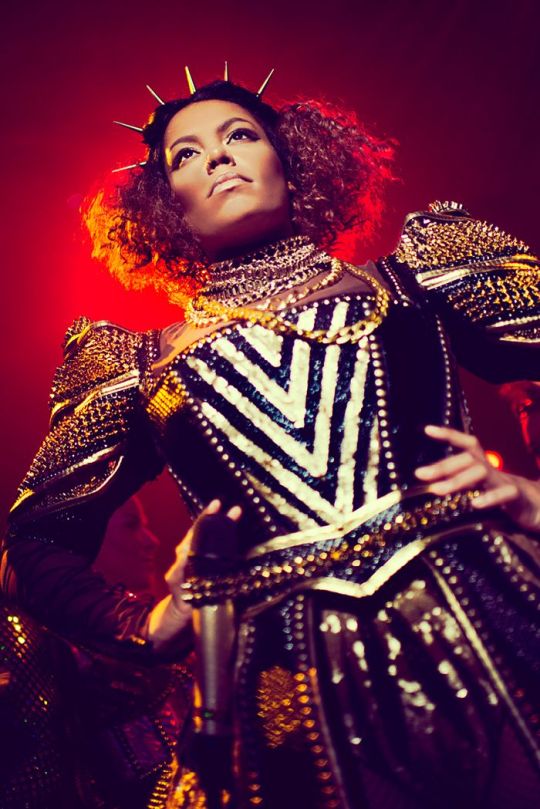
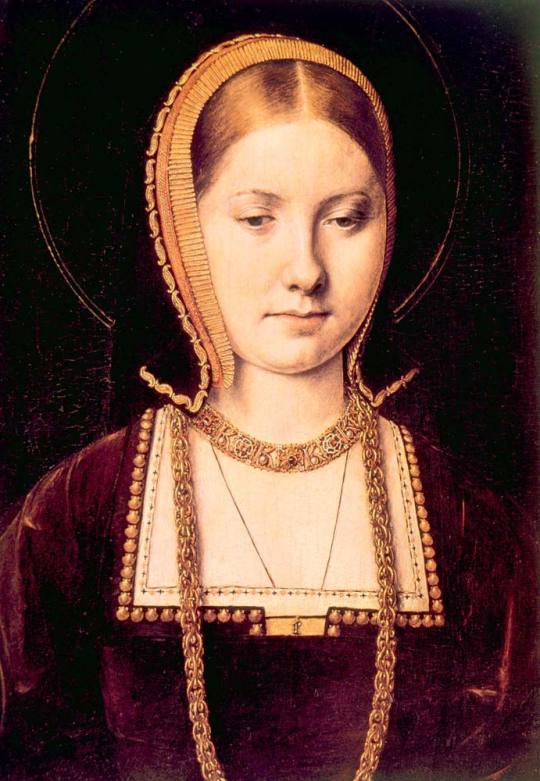
My sincerest apologies for not posting this when I said I would! I’ve been going through training for a new job online lately, which has taken up a lot of time, and I also wasn’t feeling well recently. Fear not, though- I’m back and excited to share this series of posts about what the wives of Henry VIII would have worn, as requested.
In order to keep things interesting, this post will be covering what Catherine would have worn as a younger woman when she was first married to Henry in 1509, since what she would have worn as an older woman is very similar to what Anne Boleyn would have worn when she was queen, and as I said earlier I will be making posts about all of the wives of Henry VIII in the coming weeks.
The foundation of a woman’s clothing in the early 16th century was, as it was for many centuries, a long linen shift or chemise (also sometimes called a smock in this period). Wool or silk hose (stockings) would have also been worn, however women did not wear stays or corsets in this period. Stays (known then as a “pair of bodies”) were not worn in France until the mid-1500s and were not seen in England until the late Elizabethan period (almost 100 years after Catherine and Henry married).

Over the top of the shift a kirtle, or underdress, would have been worn. If the kirtle was visible, it could have been made of silk or another type of fine fabric. If not, it was usually made of wool. Kirtles varied slightly in style- some were both a bodice and skirt, and some were just a skirt (similar to a petticoat).
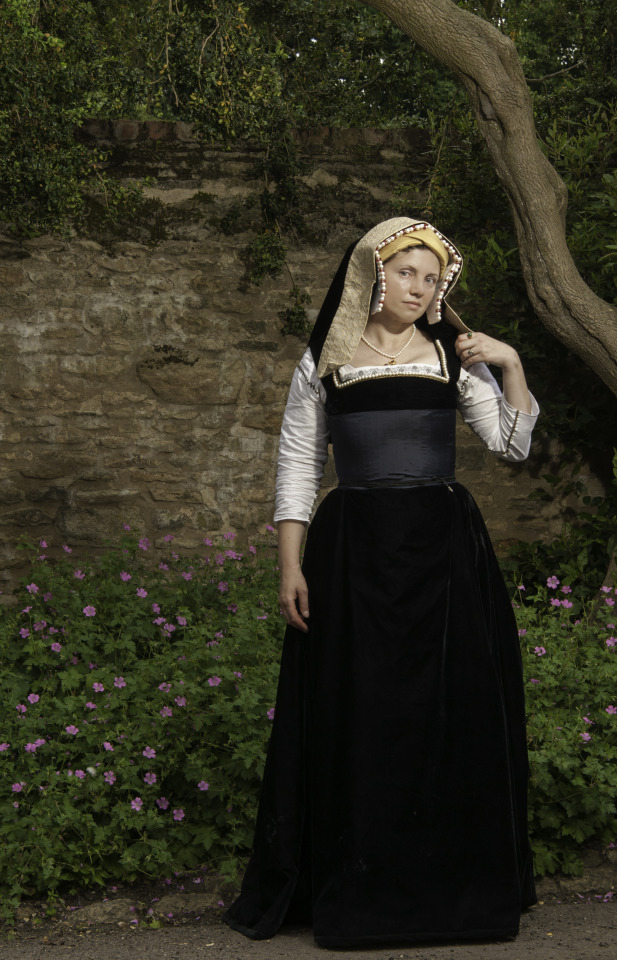
Over the top of the kirtle, the gown was worn. Gowns in the late 15th and early 16th century were voluminous and made of quite a bit of fabric, often with trains. The bodices were typically fitted, with square necklines. They also had long sleeves with large openings at the wrist to show off contrasting inner fabric. Gowns in Spain (where Catherine was originally from) were often two pieces, with a separate bodice and skirt, while gowns in England were usually one piece.
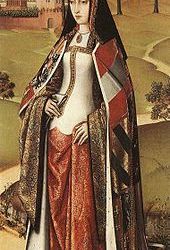
Finally, Catherine would have worn her hair up and mostly covered by a hood. There were several styles at this time, but one of the most common and the kind worn by Catherine herself and her sister Juana (seen in the painting above) was the French hood, which had a rounded shape at the front and a long veil at the back. Underneath the hood a woman would have worn a cloth cap known as a coif, allowing only the very front part of her hair to be seen.
Shoes in the early 16th century were fairly simple, flat and made of leather or silk with square toes. Jewelry was also common, with a variety of necklaces, chokers, rings, bracelets, earrings, and brooches being worn by women of a high social class like Catherine.
I hope that this was informative, and that you enjoyed it! Stay tuned for more posts about what the other wives would have worn in the coming weeks.
Sources:
https://fashionhistory.fitnyc.edu/1500-1509/
https://en.wikipedia.org/wiki/1500%E2%80%931550_in_Western_European_fashion#:~:text=Women's%20fashions%20of%20the%20early,in%20different%20parts%20of%20Europe.
10 notes
·
View notes
Note
Six the musical is about wives of Henry viii. What did the wives wear wear in real life?
Thank you for your question! The answer to it is quite long since the wives of Henry VIII lived over several decades and fashion changed during that time, so I will be answering this in parts. The first part will be posted later today and will be about what Catherine of Aragon (his first wife) would have worn. Posts about the other wives will come soon as well. I hope you don’t mind!
8 notes
·
View notes
Note
What would Eliza Hamilton and her sisters would of worn in real life? You Already talked about how working-class women of the later part of the 18th century would of worn but Eliza and her sisters would be somewhere around the middle class and I wanted to know what would ladies of that class would of worn. I think eliza would of had a hedgehog hairdo in real life.
Thank you for your question! I’m happy to elaborate more on this subject.
A quick note before we dive in, however- Eliza and her sisters were not really middle-class. While Eliza did live a slightly more humble life when she married Alexander Hamilton (although he eventually made quite a bit of money and the family lived comfortably most of the time), her upbringing was that of the closest thing the United States had to a princess at the time. Peggy and Angelica both married incredibly wealthy men as well- Peggy’s husband Stephen Van Rensselaer III was the heir to one of the largest fortunes and estates in the state of New York and Angelica’s husband John Barker Church was a businessman who made a fortune by supplying the American army with goods throughout the Revolutionary War. Eliza and her sisters were members of New York aristocracy, and as such what they wore would have been the latest fashions.
To start with, Eliza would have worn the usual undergarments from that period- a shift to protect the skin, a pair of stays to smooth and flatten the front of the bodice and improve posture, and a pair of stockings (likely made out of either wool or silk) held up with a garter ribbon tied just below the knee.
Eliza also would have worn either panniers or a hip pad. Panniers were wide metal hoops at the side of the dress which created fullness only at the sides and served to lift the skirts off of the ground as well. In earlier centuries they could be ridiculously wide, but by the late 1770s and 1780s, they had become smaller and more manageable.

Many women also wore pockets, which at the time were small bags tied around the waist, and dresses and petticoats would have had slits in the sides to accommodate them.
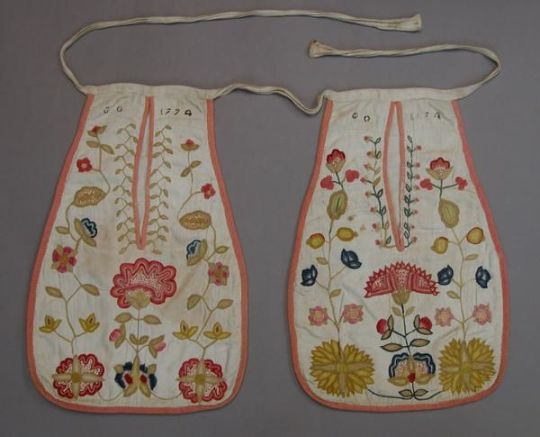
Over the top of the panniers at least one petticoat was worn, often made of either wool or linen. Eliza might have chosen to wear a linen or silk kerchief as well, for both modesty and warmth, and this would have been worn underneath the gown bodice tucked into the petticoat.
Next, a stomacher would have likely been put on. Stomachers were decorative panels of fabric that were pinned to the stays and could be mixed and matched with different gowns to create different looks.
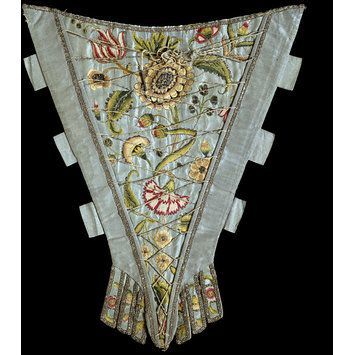
It’s finally time for the gown itself! An underskirt/petticoat was put on first and could have either matched or contrasted to the gown. Then the gown itself was put on. Gowns in the late 18th century were usually open down the front, revealing the underskirt, and were pinned into place at the sides of the bodice. Necklines were typically square, and sleeves were often three-quarter-length.
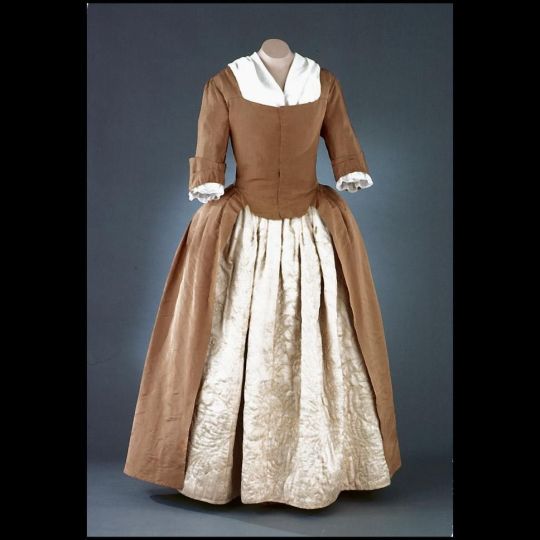
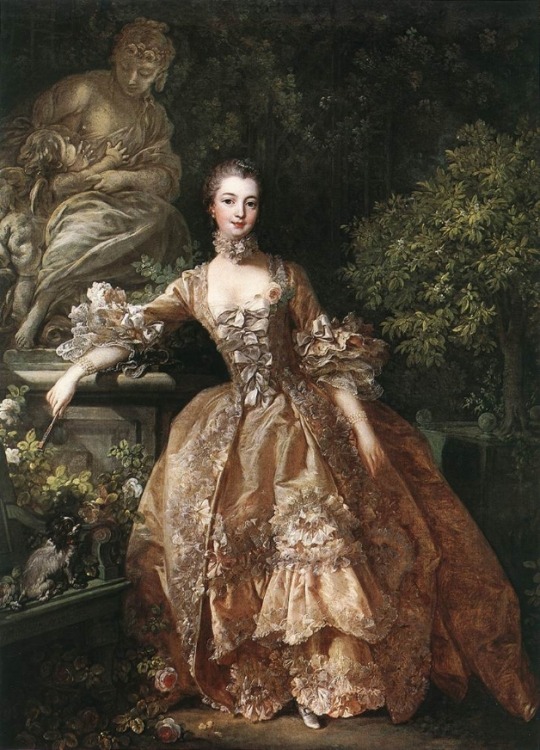
On her feet, Eliza would have worn pumps with a small heel and a buckle, either made of plain leather or decorative silk.

In terms of Eliza’s hair, there are quite a few things she could have done with it.
You referenced a hedgehog hairdo, which many women at the time did have. For those who don’t know, a hedgehog hairdo is a style in which the hair is teased high (usually with the help of pomade), and curled tightly around the face, with a few sausage curls hanging down. A great example of it can be seen in the 2008 movie The Duchess, starring Kiera Knightly:

Some women also wore wigs in various styles, including Eliza herself! She can be seen in one in the now-famous 1787 portrait of her by Ralph Earl, which she visited a debtors’ prison to sit for.
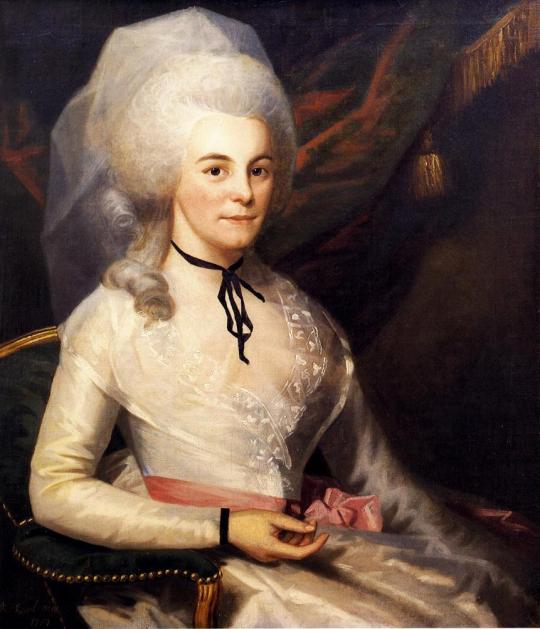
However, while both hedgehog hairdos and wigs are accurate to the period, they were mainly seen at parties and other high-society events. For every day, many women chose to simply tease their natural hair up as high as possible and wear a lace or cloth cap over it.

One thing can be said for certain when it comes to hair in the late 18th century, however- volume and curls were all the rage.
I hope that I answered your question and that this wasn’t too dry or bland. Again, thank you very much for sending it in.
Sources:
https://www.youtube.com/watch?v=UpnwWP3fOSA&t=3s
https://blog.americanduchess.com/2012/08/v229-analyzing-hedgehog-hairstyles.html
#ask#anonymous#hamilton#hamilton fanfiction#elizabeth schuyler#eliza schuyler#elizabeth hamilton#eliza hamilton#historical fashion#history#1770s#1780s
7 notes
·
View notes
Text
I'm sorry for not posting quite as much lately- I do have a few more asks to get to but the research for them is taking a bit longer than I originally thought it would.
In the meantime, I just wanted to post a friendly reminder that I do have a personal blog! I post on it daily, so if you want more of... well, me, then feel free to follow me on @historical-fangirl.
3 notes
·
View notes
Note
Do you think Marius from les mis would wear a dress as an infant?
Thank you for your question!
Yes, Marius would probably have worn a dress as an infant. Many families dressed their sons and daughters alike in dresses as infants and toddlers, mostly for the practical reason that it was easier to hand down clothing to younger children if everyone wore the same thing. This was commonplace for centuries and only ended in relatively recent history (my own grandfather was born in the late 1910s and my family has a photograph of him as a baby in which he is wearing a dress).
Most boys were “breeched” (that is, given pants to wear for the first time) by the time they were toddlers, so Marius likely would have started wearing breeches or trousers (or possibly a skeleton suit) around the age of 3 or 4.
I hope that answered your question!
#ask#anonymous#les miserables#les miserables fanfiction#marius pontmercy#1800s#1810s#history#historical fashion
5 notes
·
View notes
Note
Hi! I really liked your post about the Newsies’ views on gay rights, and I was wondering if you have any information about the views of the characters of Bandstand on it. Like, I know there was a cut scene where Jimmy comes out and Donny seems at least somewhat accepting; how do you think the other characters of Bandstand would react to Jimmy coming out, and gay rights in general? I love your blog by the way!
Thank you so much! I’m always happy to hear that people like my blog and that the posts I make are helpful and informative.
So, much like with the Newsies post I made on this topic (which can be found here for anyone who hasn’t read it yet and would like to) this is a complicated question that there is no one easy answer to. However, I will do my best to examine as many angles as possible when answering this to provide you with as clear a picture as possible of how history relates to the show canon in regards to LGBTQ+ people and their rights.
The LGBTQ+ community in the 1940s was still a long way away from being accepted by most of society. Being gay was illegal, and would remain so until the 1960s when individual states began to legalize it (although being gay was not legalized in all 50 states until 2003). However, some strides forward were being made in the name of gay rights at the time.
In 1924, The Society for Human Rights was founded by Henry Gerber in Chicago. It was the first documented gay rights organization in the United States and marked a big step forward for the LGBTQ+ community as a whole. By the 1940s, many cities had gay bars and thriving (if hidden) gay communities were beginning to take shape. Cleveland’s first gay bar, The Cadillac Lounge, was opened in the 1940s. These bars were subjected to frequent raids, and so were by no means perfectly safe, but the fact that they existed in relatively large numbers across the country is a testament to the slowly changing opinions of people at the time.
World War II marked even more changes within the LGBTQ+ community. Due to a variety of factors, a community of gay people began to take shape under the surface of the US military. At one point during the war the Women’s Army Corps contained such a large number of lesbians that when the army tried to kick them out, they found that doing so would result in the majority of their staff being fired and so were forced to back down (you can read more about that remarkable instance here). This is probably one of the main reasons why Donny seems so accepting of Jimmy in the cut scene you referenced- as a member of the US Amry during WWII it’s highly likely that he came into contact with a least a couple of gay people before meeting Jimmy (he could also be some form of LGBTQ+ himself, although that, of course, depends on your own personal headcanons).
With that very brief history out of the way, let’s now get into what the other members of the Donny Nova Band might have thought about gay rights and gay people in the 1940s. Please note, however, that this is all pure conjecture on my part and that you can really headcanon anything you want in regards to this (one of the perks of Bandstand being a fictional show).
As I said before, Donny, Johnny, Nick, Wayne, and Davy would have probably met at least one or two gay people before during their service (and possibly in their civilian lives as well), and so Jimmy being gay wouldn’t be as big a shock for them as it might be for someone else. This doesn’t necessarily mean that they would be completely accepting of Jimmy, of course, but it does make it a bit more likely that they would be. In my personal opinion, homophobia usually comes from a place of ignorance, and the guys in the band wouldn’t be as ignorant about the LGBTQ+ community as some other people at the time might have been.
This brings us to Julia. She would probably be to most sheltered and ignorant of LGBTQ+ people, given that she never served and grew up Catholic (and as I’m sure many people know, the Catholic church doesn’t exactly have a favorable opinion of LGBTQ+ people, even today). Taking this into consideration, it would probably be the hardest for her to come to terms with Jimmy being gay at first. That being said, she clearly does eventually come to terms with it in some way since she writes and sings as openly as she can about him and the trauma he experienced related to his boyfriend being killed in the song Welcome Home, and I doubt she would have done that had she been harboring any kind of ill-will towards Jimmy with regards to his sexuality.
To summarize my very long-winded response (I’m oftentimes incapable of giving short answers, my apologies): Based on both historical facts and the musical canon, it is very likely that Jimmy would face homophobia from the outside world, but not from the members of the band themselves. This isn’t to say that the members would be perfectly understanding of him at all times, but rather that they clearly value him as a person regardless of his sexuality and are willing to look past whatever homophobic values they might have been raised with in order to accept him.
I hope that this answered your question! Again, this is a hard topic to talk about in any kind of definitive way, and so I welcome anyone else to chime in with their own opinions on this.
Sources:
https://en.m.wikipedia.org/wiki/LGBT_in_the_United_States#
https://www.cnn.com/2015/06/19/us/lgbt-rights-milestones-fast-facts/index.html
https://www.nationalww2museum.org/war/articles/gay-and-lesbian-service-members
#ask#anonymous#bandstand#bandstand fanfiction#donny nova band#jimmy campbell#lgbtq+ history#lgbtq+ rights#history#military history#wwii history#1940s#donny novitski#julia trojan
17 notes
·
View notes
Note
What age Cosette would start wearing dresses with long skirts? Once in the care of Jean she would wear dresses that are shorter but I think she wold wear some form of drawers/trousers that would be seen underneath any dresses young Cosette would be wearing.
Thank you for sending in a question!
So, as I’m sure many people are aware if they know anything about dress history (or have followed this blog for any length of time), it was common in the 19th and early 20th centuries for young girls to have a “coming out” around the age of 17 or 18 (or sometimes 16), at which point they would begin to wear long skirts and pin their hair up (and enter the marriage market, but that’s a post for another time). This was first starting to become a “thing” within society in the late 18th and early 19th centuries, which is when Cosette would have been a child (she was born in 1815), because for the first time young girls were wearing clothing designed specifically for them. And the dresses they wore often had much shorter skirts.
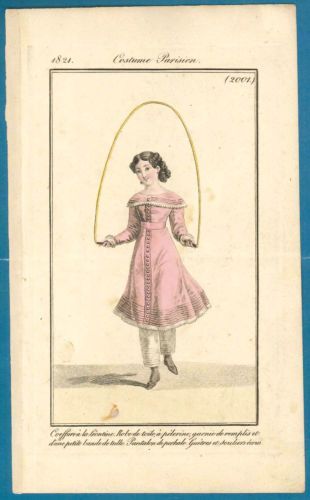
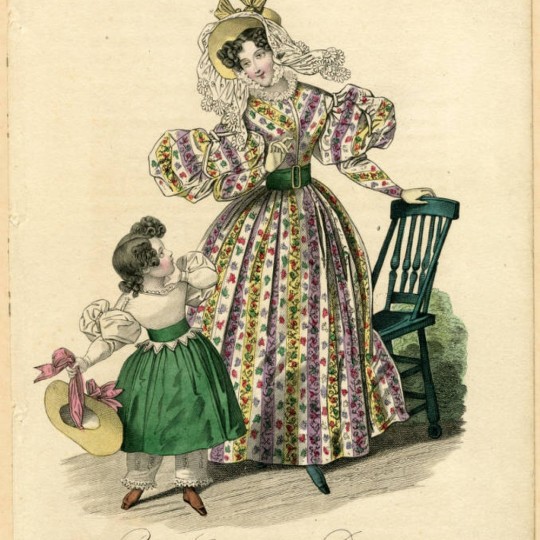
As you already alluded to in your ask (and as you can see in the images above), the shape of a young girl’s dress was much the same as the fashionable silhouette of the 1820s and 30s, but with one notable difference- the skirts were quite short and had long white drawers (often called “pantalettes”) underneath that could clearly be seen. This was really the mark of adulthood at the time- whether or not you could see a woman’s drawers.
Now that we’ve established what exactly we’re talking about, it comes time to actually answer your question! As I said, by the late 19th century the most common age for a young girl to start wearing long skirts was 16-18 years of age, but in the earlier half of the 19th century it could be a bit earlier. A quote that I found particularly interesting (and amusing) when conducting research for this post was a description of Princess Charlotte in 1811, when she was 15. She was apparently “sitting with her legs stretched out after dinner and showing her drawers which it seems she had and most young women now wear.” The reason this note was being made about Princess Charlotte’s behavior is because she was considered too old to be making a display like that, and should have been behaving more like an adult by not showing her drawers.
However, in Les Miserables it is quite evident that Jean Valjean is resistant to the idea of Cosette growing up and leaving him (in the book he actually briefly contemplates killing Marius in order to stop him from marrying Cosette), so I believe it stands to reason that he would try to delay her wearing adult clothing for as long as possible. She does eventually start wearing dresses with long skirts, though, as in both the musical and the book she is wearing adult clothing by the 1832 June Rebellion, when she would have been 17.
Personally, I headcanon that Cosette started wearing adult dresses around the age of 15, but it’s really up to you what you think. I hope that this helped, and if anyone else wants to weigh in on this topic then feel free to!
Sources:
https://janeausten.co.uk/blogs/fashion-for-children/dressing-the-part-childrens-clothing-in-regency
#ask#anonymous#les miserables#les miserables fanfiction#cosette fauchelevent#jean valjean#historical fashion#history#french history#1820s#1830s
21 notes
·
View notes
Text
My Posts About Tuck Everlasting
In honor of the 1st day of August, 2020, here is a list of the posts I have made so far on this blog about Tuck Everlasting (incidentally, this post is also the 100th post I have made on this blog, which is a bit of a milestone!)
How the Tucks Would Have Dressed in 1808 (With A Note About Winnie Foster’s Clothes in 1893)
Where Did the Tucks Come From?
What Miles and Jesse Would Have Worn as Children
What Winnie Would Have Worn as a Young Adult
What Mae and Angus Would Have Worn When They Got Engaged
Europe in 1808 vs. Europe in 1893- A Comparison Between the Time of the Tucks and the Time of Winnie Foster
What Miles’ Son Thomas Would Have Worn as a Child
What Winnie Might Have Worn as an Older Woman
#tuck everlasting#tuck everlasting fanfiction#jesse tuck#miles tuck#mae tuck#angus tuck#thomas tuck#about the blog#musical theatre#masterlist#history
18 notes
·
View notes
Note
any more info on bandstand?
Thank you so much for asking! It’s been ages since I’ve had an excuse to research things related to Bandstand, and I was very happy to do it. Here is a list of interesting facts about WWII and the Donny Nova Band that I haven’t yet covered on this blog.
The headline in the Cleveland Plain Dealer morning edition on December 8th, 1941 (the day after the attack on Pearl Harbor) was “Japs War On U.S., Britain; Bomb Hawaii, Phillippines; Congress To Hear F.D.R.”
Men in the 37th Infantry Division (Donny and Michael’s division) were assigned companies based on their hometowns, the idea being that this would foster an important sense of community for them. This is likely how Donny and Michael ended up meeting and serving so closely together.
Here is a link to a recording of the MBS News Bulletin announcing the surrender of Japan on September 14th, 1945. I love this recording because you can hear people in the newsroom running around and generally freaking out while the announcement is being read, and it features some very fun 1940s swing music. This recording is also part of a big collection of WWII-related sound clips from 1945, so have fun listening!
In 1946 a movie called Deception came out. It is about a piano teacher who believes that her fiance was killed on the battlefield during WWII, so she starts dating a wealthy composer. However, everything is thrown into turmoil when her former fiance miraculously returns from the dead. You can find its IMDb page here. Do with this information what you will.
The Cadillac Lounge was Cleveland’s first gay bar. It opened in the 1940s (although I was unable to find an exact year).
I hope that you found these facts interesting! I will also link a few of the other posts I’ve made about Bandstand below, in case anyone wants to give those another look, and if you or anyone else has any other questions then feel free to send them in!
Dressing Julia Trojan
Davy Zlatic’s Military Division
The 37th Infantry Division
29 notes
·
View notes
Note
What would the soliders’ uniform in Hamilton would look like in real life?
Thank you so much for your question! My 10-year-old self (who was quite obsessed with the Felicity American Girl movie and thus with the Revolutionary War period in general) is very excited to answer this.
Uniforms during the Revolutionary War varied somewhat, especially in the early days of the conflict. The Continental Army was primarily made up of the members of various militias, which were small groups of civilian men who had been assigned the task of protecting their communities from any outside threat or civil unrest that might arise. As such, most of these men didn’t have specific uniforms, although certain trends did prevail with the type of clothing they wore. Later in the war, however, the now-iconic blue uniforms with white facing and waistcoats came into being, and many soldiers started wearing those.
In the interest of thoroughness, I will highlight the two main types of uniforms that were worn by different members of the Continental Army. First, an ordinary militiaman. He would have worn a plain white shirt, cut in the style of the 18th century to be comparatively loose and shapeless, and made of cotton muslin, linen, or wool. A neck stock made of either linen or leather would have also likely been worn (for those of you who don’t know, a neck stock is a long, narrow strip of fabric wrapped around the throat in the style of a cravat). Next, a pair of either trousers or breeches would have been worn. These could have been any color, although were often either white or brown, and made of either canvas or wool.
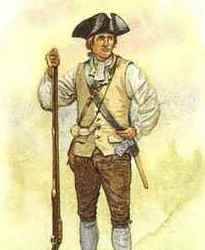
Over the top of the shirt, a simple waistcoat would have been worn, usually made out of canvas, wool, or linen. It could have been any color, although more natural earthy colors were the most common (as I’m sure I’ve said before, aniline dyes wouldn’t be invented until 1858, and so all clothing in the 18th century had to be dyed using natural colors). Either a coat or a hunting shirt would have likely been worn over the top of everything, especially in winter months, and these could have been made of either wool, linen, or cotton and were usually either brown or white. Finally, a militiaman would have likely worn a tri-corn hat on his head and simple leather boots or flat shoes with a buckle and wool stockings on his feet. Militiamen were often referred to as “citizen soldiers”, and so their clothing was similar to that of everyday civilians because that is what they were before becoming soldiers (if you’d like to read more about what civilians wore in the 18th century, feel free to have a look at this post that I made a little while ago).
Next, we have a standard soldier. In 1779, George Washington decreed that Continental Army uniforms should consist of blue coats and white waistcoats, although the colors of the facings (the fabric along which buttons were placed) varied depending on which state the soldier lived in. Blue coats with white facings (the kind that the characters of Hamilton and Washington themselves wear in the musical) were worn by soldiers from New Hampshire, Rhode Island, and Massachusetts, as well as by soldiers who were members of the Light Dragoons. Blue coats with red facings (such as the kind worn by many ensemble members in Hamilton) were worn by soldiers from Pennsylvania, Delaware, Maryland, and Virginia. Soldiers from New York and New Jersey, meanwhile, wore blue coats with buff (tan) facings, while soldiers from North Carolina, South Carolina, and Georgia wore blue coats with blue facings. And, as alluded to a minute ago, officers such as Washington and Hamilton almost always wore blue coats with white facings.
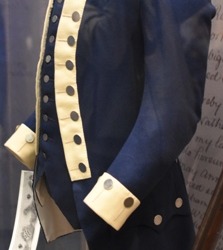
All in all, the costumes in Hamilton strike a wonderful balance between historical accuracy and practicality for the sake of entertainment, and the soldier’s uniforms are quite accurate in terms of how they look. For a much more in-depth analysis of the Hamilton costumes than I could ever provide, I highly recommend watching Bernadette Banner’s video about them. I also hope that I answered your question sufficiently! The Revolutionary War is one of those wars where almost everyone wore something slightly different, and what a soldier wore really depended on their individual circumstances and what part of the army they were a member of. As I’m sure many people are aware, the United States army was quite a rag-tag affair in the beginning, and the clothing people wore oftentimes reflected that.
Sources:
https://www.youtube.com/watch?v=--mGNt-t0PI
https://historyofmassachusetts.org/uniforms-revolutionary-war-soldiers/
#ask#anonymous#hamilton#hamilton fanfiction#alexander hamilton#george washington#historical fashion#history#military history#revolutionary war#1770s#1780s
7 notes
·
View notes
Note
What sort of clothing Winnie would be wearing in her old age?
Thank you for your question! I’m sorry it took me so long to answer but to be honest the answer to this question is a tad bit complicated.
So, Winnie was born in 1881 or 1882 since she’s 11 in August of 1893. While it’s never stated (in the musical at least) how old she lives to be, the implication is that she was quite elderly when she passed. For the purposes of this ask, we’ll say that she lived to be 100.
Winnie would have been 100 in the early 1980s, which as I’m sure many people know was a time with a very... interesting overall style. It was a period characterized by large hairdos, loud colors and patterns, and (for the women at least) lots of shoulder pads. However, as with fashion all throughout history, the most fashion-forward things tend to be worn by the younger generation (this isn’t to say that older people can’t wear newer styles, it’s just that, in my experience at least, they tend to favor and be more comfortable wearing older styles). Thus, I highly doubt Winnie would have chosen to wear the height of 1980s fashion, but she probably would have implemented some elements of the 1970s and 80s into her wardrobe, mixing those with the more subdued looks of the 1940s, 50s, and 60s (the decades of her middle age).
Winnie might have chosen to keep her hair long and worn up rather than cutting it, but she probably would have worn some form of pants or trousers at least some of the time. She might have chosen to wear a more modest blouse or dress but would have worn it with a pair of Converse sneakers (as an interesting side note, the Converse company manufactured their first pair of the now-famous shoes in 1917, just over 100 years ago). In short- Winnie’s clothing choices as an old woman are really up to your own personal headcanons, but they would have been much, much more similar to what we wear today than the things she wore in her youth would have been, and they would have probably looked very similar to the costume the elderly Winnie wears in the show.
I hope this answered your question! I apologize if my answer seemed limited, but I struggled to answer this question a little bit. I honestly don’t know nearly as much about the fashions of the 1980s as I do about the fashions of the 1880s, but I hope that this was at least a little bit helpful to you.
#ask#anonymous#tuck everlasting#tuck everlasting fanfiction#winnie foster#historical fashion#1980s#history
12 notes
·
View notes
Note
These are both excellent additions!
first of all, i love this blog so much already. i'n so glad you created something like this. okay my question is, in the time of newsies, what was their views on gay rights?
Thank you so much! I’m so glad to hear that people enjoy what I do here.
A brief warning for this post- it will contain discussions of period-typical homophobia and other sensitive subjects. I will do my best to tag everything, but if things related to homophobia bother you I would recommend proceeding with caution when reading this.
So, this question is a little bit difficult to answer in that there’s no real way of knowing what individual people would have thought about gay rights and gay people in general without asking them specifically (which obviously isn’t an option since all the historical newsboys are long gone and the fictional characters are just that- fictional). However, we can make some educated guesses based on the views of the general public towards LGBTQ+ people at the time.
As I’m sure many people are aware, the general public attitude towards the LGBTQ+ community in the 1890s wasn’t exactly favorable. Homophobia was rampant in much of society, and being gay was itself a crime. The existence of LGBTQ+ people wasn’t discussed outright by most of “polite society”, and a large number of people at the time simply ignored the fact that “those sort of people” existed. However, this doesn’t necessarily mean that all of the newsies would have been violently homophobic.
It’s definitely worth mentioning that statistically, it’s almost certain that at least a few of the newsies would have been members of the LGBTQ+ community themselves. Whether or not they would have been comfortable expressing their sexuality or gender identity is up for debate, however, and largely depends on how they as an individual were raised and what the opinions and beliefs of their closest friends and family were. A newsboy from a more conservative cultural or religious background or who spent a lot of time around those who were more outwardly homophobic would probably have been more likely to spout those same views themselves and repress any part of their sexuality or gender identity that was outside of societal norms at the time. Conversely, a newsboy from a more accepting or liberal background might be more readily accepting of both others and their own feelings.
That being said, as people who lived on the margins of society already the newsboys would probably be more likely to be accepting and inclusive of others as opposed to overtly homophobic. New York City at the time was a slightly more liberal place than other parts of the country (it was by no means perfect and racism, sexism, ableism, and homophobia were still rampant, it was just a tad bit less rampant than in other places). The Newsboy’s Lodging House itself had a relatively open-minded policy for the time- according to the New York Journal in an 1896 article, the lodging house “would reject no boy on account of color, nationality, or religion.” So, it stands to reason that the newsboys wouldn’t be quite as inclined to violent homophobia.
However, it is important to acknowledge that “acceptance” in the 1890s didn’t mean what acceptance means today. Acceptance of someone being a member of the LGBTQ+ community in the 1890s largely meant that you wouldn’t be reported to the police, not that the other person was necessarily “okay” with it. A good example of the attitude towards many LGBTQ+ people around the turn of the century is a plotline in the show Downton Abbey- when one of the main characters (who happens to be gay) is outed, many people express sympathy for him and say that they’re sorry he had to be born “like that”. Not a ringing endorsement by any means, and still extremely homophobic by today’s standards, but overall a much better reaction than being thrown in prison just for existing.
To summarize all of my disjointed rambling- if you want to write “historically accurate” attitudes towards LGBTQ+ people and LGBTQ+ rights in the time of Newsies, the best way to do that is to include a range of opinions. Some newsies would have unfortunately been violently homophobic, others passively homophobic, and still others might not have cared much one way or the other or might have been LGBTQ+ themselves. It really depends on how you personally choose to headcanon them and their backgrounds.
I hope that this post answered your question. Thank you for sending it in, this is a very interesting topic that I really only scratched the surface of. If you’re interested in other people’s perspectives on this question, the blog @newsiesquare answered a question similar to this on their blog. And if you have any further questions, please don’t hesitate to ask!
30 notes
·
View notes